2017-2018学年高中英语Module5TheGreatSportsPersonalitySectionⅢGrammar-复习状语从句教学案外研版必修5
高中英语 Module 5《The Great Sports Pers

Module5《The Great Sports Personality》说课稿I. 教学内容分析本次做课的内容是外研版的“新标准”高中英语教材第五册(必修)第五模块“The Great Sports Personality”中的阅读课文“A Life in Sport”。
本模块的话题是中学生比较感兴趣的体育名人,涉及到中外各种赛事和各项体育运动的多名体育明星比如体操王子李宁、拳王阿里、肯尼亚长跑名将基普·凯诺、球王贝利以及马拉松运动。
通过学习,希望同学们热爱体育运动,学习体育健儿们不畏艰难、奋力拼搏的精神。
Reading and Vocabulary是一篇介绍体操王子李宁的文章。
通过了解李宁辉煌的运动生涯和退役后在商海中的奋斗以及他为中国体育事业做出的不懈努力,号召同学们热爱祖国、热爱运动,学习体育健儿们不畏艰难、永不放弃、奋力拼搏的精神。
II.教学目标及重难点1. 教学目标(1)阅读中能识别新学词汇、短语并推断出大意。
(2)正确灵活使用Skimming, scanning等阅读策略。
(3)了解体操王子李宁的运动生涯及搏击商海的经历。
(4)分析文章结构,根据文字表面意思对其深层含义做出正确合理的推断。
2. 教学重点(1) 学习如何谈论体育名人以及他们的个人影响。
(2) 正确灵活使用Skimming, scanning等阅读技巧。
3. 教学难点(1) 让学生根据文字表面意思对其深层含义做出正确合理的推断。
(2) 通过学习,陶冶学生的情操,要求学生热爱体育运动,学习体育健儿们不畏艰难、奋力拼搏的精神。
III.人文目标学习策略:通过谈论体育人物引出话题,促进与他人的交流。
文化意识:关心和了解体坛赛事,增强健身意识。
情感态度:学习体育明星们的拼搏精神,在学习上刻苦用功、努力拼搏。
IV. 设计思路及理念1.整体设计思路:课程标准将英语课程的总体目标确定为学生综合语言运用能力的形成,而这一能力的形成是建立在学生的语言技能、语言知识、情感态度、学习策略和文化意识等素养的整合发展的基础之上的。
2017-2018学年高中英语必修五外研版课件:Module 5 The Great Sports Personality 5.1

本句是复合句,I set and was able to reach是定语从句,修饰先行词 the goals,省略了关系代词that/which。
理解诱思
1.Joyner-Kersee
.
A.won six Olympic gold medals
B.is the greatest female athlete of the 20th Century
ⅠⅡⅢⅣ
While-reading Ⅲ.根据课文内容,完成下列表格
Li Ning’s achievements as a gymnast
He was called the prince of
1.
.
He had won 106 gold medals in major
competitions across the world.
“Success for me is never quite completed,” says Jackie JoynerKersee,a six-time Olympic medalist who is considered to be one of the greatest female athletes of the 20th century.“There are successful moments from the point of the goals I set and was able to reach.That doesn’t mean the work is done.”
高中英语必修5(外研版)Unit 5 The Great Sports Personality 知识点总结
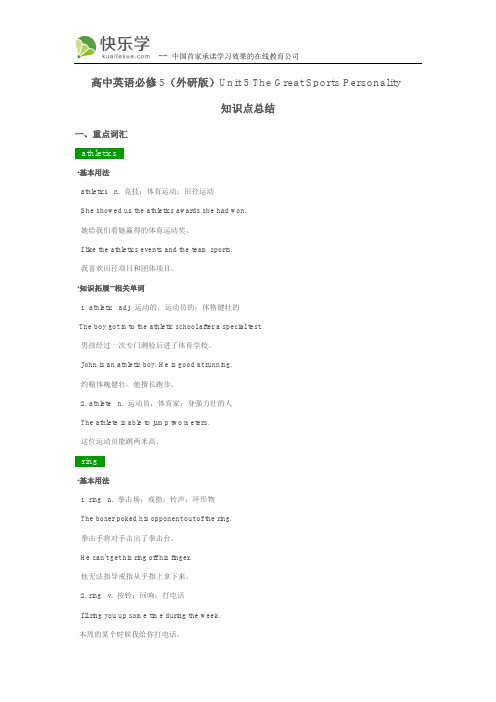
高中英语必修5(外研版)Unit 5 The Great Sports Personality知识点总结一、重点词汇athletics·基本用法athletics n. 竞技;体育运动;田径运动She showed us the athletics awards she had won.她给我们看她赢得的体育运动奖。
I like the athletics events and the team sports.我喜欢田径项目和团体项目。
·知识拓展--相关单词1. athletic adj. 运动的,运动员的;体格健壮的The boy got in to the athletic school after a special test.男孩经过一次专门测验后进了体育学校。
John is an athletic boy. He is good at running.约翰体魄健壮。
他擅长跑步。
2. athlete n. 运动员,体育家;身强力壮的人The athlete is able to jump two meters.这位运动员能跳两米高。
ring·基本用法1. ring n. 拳击场;戒指;铃声;环形物The boxer poked his opponent out of the ring.拳击手将对手击出了拳击台。
He can't get his ring off his finger.他无法指导戒指从手指上拿下来。
2. ring v. 按铃;回响;打电话I'll ring you up some time during the week.本周的某个时候我给你打电话。
track·基本用法1. track n. 轨道;足迹;小道I like to watch field and track events.我喜欢观看田径比赛。
What you just said is completely off the track.你刚才讲的话彻底离题了。
外研版高中英语必修5Module5TheGreatSportsPersonality4课时教案附教学反思
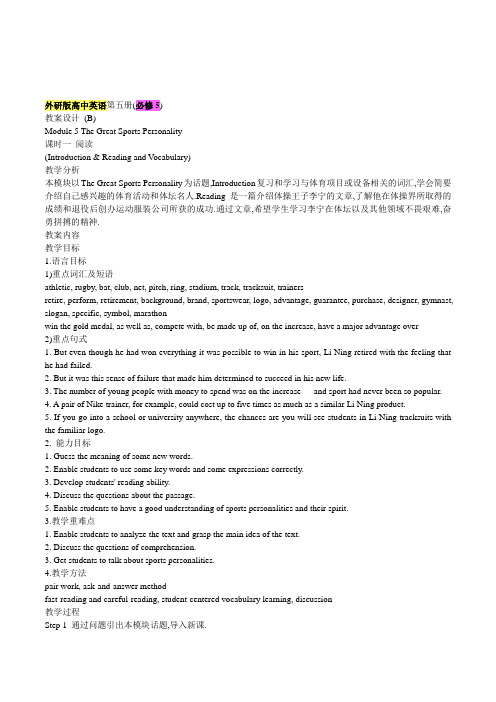
外研版高中英语第五册(必修 5) 教案设计 (B) Module 5 The Great Sports Personality 课时一 阅读 (Introduction & Reading and Vocabulary) 教学分析 本模块以 The Great Sports Personality 为话题,Introduction 复习和学习与体育项目或设备相关的词汇,学会简要 介绍自己感兴趣的体育活动和体坛名人.Reading 是一篇介绍体操王子李宁的文章,了解他在体操界所取得的 成绩和退役后创办运动服装公司所获的成功 .通过文章,希望学生学习李宁在体坛以及其他领域不畏艰难,奋 勇拼搏的精神. 教案内容 教学目标 1.语言目标 1)重点词汇及短语 athletic, rugby, bat, club, net, pitch, ring, stadium, track, tracksuit, trainers retire, perform, retirement, background, brand, sportswear, logo, advantage, guarantee, purchase, designer, gymnast, slogan, specific, symbol, marathon win the gold medal, as well as, compete with, be made up of, on the increase, have a major advantage over 2)重点句式 1. But even though he had won everything it was possible to win in his sport, Li Ning retired with the feeling that he had failed. 2. But it was this sense of failure that made him determined to succeed in his new life. 3. The number of young people with money to spend was on the increase --- and sport had never been so popular. 4. A pair of Nike trainer, for example, could cost up to five times as much as a similar Li Ning product. 5. If you go into a school or university anywhere, the chances are you will see students in Li Ning tracksuits with the familiar logo. 2. 能力目标 1. Guess the meaning of some new words. 2. Enable students to use some key words and some expressions correctly. 3. Develop students' reading ability. 4. Discuss the questions about the passage. 5. Enable students to have a good understanding of sports personalities and their spirit. 3.教学重难点 1. Enable students to analyze the text and grasp the main idea of the text. 2. Discuss the questions of comprehension. 3. Get students to talk about sports personalities. 4.教学方法 pair work, ask-and-answer method fast-reading and careful-reading, student-centered vocabulary learning, discussion 教学过程 Step 1 通过问题引出本模块话题,导入新课.Do you like sports Which sports do you like most Can you name several different kinds of sports Step 2 教师介绍关于体育类的词汇,学生完成 Activity 2 and Activity 3 中的词汇练习,教师可以在此基础上进 行适当拓展. Step 3 看图说话,学生以小组形式,分别对 Activity 1 中的三幅图片进行描述. Step 4 两个人一组,围绕自己喜欢的体育项目和体育明星展开对话. My favourite sports What Where How often How good Who with Step 5 Lead-in: 播放关于李宁的录像片段,引出阅读的中心人物. Step 6 Pre-reading: scanning the passage and get the main idea of the text. Part 1 (Para 1) Li Ning was a great sportsman. Part 2 (Para 2-4) Li Ning succeeded in his new life as a businessman. Part 3 (Para 5) Li Ning's dream of opening a school for gymnasts came true. Step 7 While-reading: 1. Vocabulary: check the meaning of these words. Make sure students can read the words correctly and understand the meanings. "compete, fail, guarantee, perform, retire, succeed". Finish Activity 2 and Activity 6 2. Skimming: read the text again, get some detailed information and check the true statements in Activity 3. 3. Further reading: Answer the questions: 1) How many gold medals had he won when Li Ning retired 2) Whose names were on the list together with Li Ning 3) What is the red logo made up of 4) What is their major advantage over others 5) Are Li Ning products popular in some schools 6) Was it Li Ning's goal to make money when he retired 4. Read to transfer information At the 1982 World Championship He won six gold medals. At the 1984 Olympics He won three gold medals, two silver and a bronze. At the age of 26 He had won 106 gold medals in major competitions across the world. In the 1988 Seoul Olympics He was disappointed for not performing well. A year after his retirementHe began a new career --- as a businessman. In 1991 He opened a school for gymnasts. Since 1991 He has continued to help young people to achieve their sporting ambitions. In 1999 His name was on the list of the greatest sportsmen and sportswomen of the twentieth century. In a few yeas after his new career His company won more than 50% of the national market. Step 8 Post-reading: Discussion: discuss the two questions in Activity 4. Step 9 Homework 1. Workbook on P92 Exx. 5,6,7. 2. Write a short passage about Li Ning's life. 课后反思: 在导入部分,教师引导学生围绕自己感兴趣的体育运动和喜欢的运动明星展开听说活动 ,学习有关词汇,为阅 读的学习作好准备. 在阅读课讲授中,以 Lead-in 激发学生的阅读兴趣,引入话题.通过 Pre-reading 部分总结每部分的大意.这也是本 课主要训练学生的阅读能力——阅读概括文章和段落大意的能力.通过图片展示,泛读,精读,帮助学生理清思 路,了解文章的脉络,通过填写表格的形式使学生能够按照时间顺序复述文章大意,获得更多的信息,了解李宁 的人生路程.最后以讨论的形式启发学生对课文的深层意义进行思考:我们应该勇敢面对失败,不能气馁,要振 作精神以取得更大成就(尤其针对那些缺乏信心,恒心和信念的学生).在课堂教学中,教师应该努力激发学生参 与教学活动的热情,积极思考,相互讨论,共同协作. 教学点评: 教师在处理阅读教学中,以启发学生讲述自身对体育运动和体育明星的喜爱为切入口 ,顺利进入导入环节,教 学过程和内容紧扣阅读文章主题 .教师在培养学生阅读技巧和方法的同时 ,渗透相关词汇的学习,有效地帮助 了学生对文章的理解.教师利用表格形式处理文章的重点知识,培养了学生捕捉相关信息归纳提炼的能力,教 学体现了新课程所倡导的教师变"教"为"导",学生自主学习合作学习的教学理念. 高级教师 周鸣 课时二 听说 (Listening & Function and Speaking & Everyday English) 教学分析 本模块听力材料是关于三个体育明星的介绍,分为三个部分,判断,填空和回答问题.Function and Speaking 学习 和掌握一些关于表示同意或不同意的表达法.Everyday English 学习和掌握几个口语中的习惯表达. 教案内容 教学目的 1.语言目标 (1)重点词汇和短语 final, champion, quality vote for, even if, after all, of all time, up to you, not the poin, so what (2)重点句式 1. That's not the point. 2. I agree absolutely. 3. I'm afraid I don't agree.4. Team sports are more enjoyable than sports you do by yourself. 5. It is more important to compete than to succeed. 2.能力目标 1. Listen to the famous persons in the sports field. 2. Develop students' listening ability of seizing the useful information by listening to the programmes. 3. Express agreeing and disagreeing: degrees of certainty. 4. Learn several phrases: up to you; not the point; so what…. 3.教学重难点 How to catch the key words in the listening. 4.教学方法 Listening-and-answering activities, speaking, individual or pair work. 教学过程 Step 1 Listening 1.看课本上的三幅图片,根据图片下面提供的信息,讨论体育明星和他们从事的体育项目 ,为听力提供一些背 景知识. 2.听对话的第一部分录音,完成 Activity 2 的练习. 3.听对话的第二部分录音,完成 Activity 3 的练习.听前应提示学生先阅读本活动中的问题,然后带着任务听录 音.可根据学生情况,放两遍录音,根据需要,适当停顿. 4.听录音,填写 Activity 4 中有关三位体育明星的信息. 5.两人活动,讨论并回答 Activity 5 中的问题,尽可能多地说出已获得的有关三位体育明星的信息. Step 2 Function: Agreeing and disagreeing: degrees of certainty 1. That's not the point. 2. I agree absolutely. 3. You may be right. 4. I'm afraid I don't agree. 5. You're right about that. Step 3 Speaking: Pair Work: make a reply to show degrees of certainty by using the above sentences. Step 4 Everyday English 1. 朗读例句,根据句意判断黑体字部分的意思,做出选择. 2. 理解日常英语. 1)up to you 2)not the point 3)So what 教学反思 本课是一堂听说课,练习学生听的技能和口语的交际能力 .根据所给的听力材料和图片信息,使学生能挖掘相 关的信息点.在处理听力练习之前,可以先给学生介绍一些与听力材料相关的背景知识,以降低听力的难度,提 高学生的兴趣与自信心.在听前应提示学生先阅读问题,然后带着任务听录音.通过活动学习 "同意和不同意" 的常见表达法,使其为意思的准确表达而服务. 教学点评: 听力教学是本模块教学中的难点 .教师充分展示身边可利用的资源辅助听力训练 ,先以简单的背景知识介绍 为铺垫,使学生在掌握一定必要知识,了解一些相关信息的基础上完成听力教学.其结果降低了听力难度,增强 了学生的自信心,提高了学生听和理解的能力.教师在教学中有机地将带着问题的"听"与归纳听到的信息表达 出来的"说"结合起来,体现了任务型教学的同时也帮助学生完成了知识学习到知识应用的自然转化. 高级教师 周鸣第三课时 语法 ( Grammar→Revision of adverbial clauses) 教学分析 本模块主要复习状语从句,包括时间,条件和让步状语从句;以及几个重要的介词短语作定语的用法.通过学习, 使学生能够理解不同类型状语从句的功能,理解根据所给出的主句写出不同类型的状语从句. 教案内容 教学目标 1.语言目标: 1)重点词汇和短语 score, ministry until, ever since, unless, as long as, although, even if, whatever, whenever, however 2) 重点句式 If you go into a school or university anywhere, the chances are you will see students in Li Ning tracksuits with the familiar logo. Whenever Chinese athletes step out onto the track during the 2008 Olympics, they will be wearing Li Ning tracksuits. But even if he had won everything it was possible to win in his sport, Li Ning retired with the feeling hat he had failed. 2.能力目标:To revise the adverbial clauses and preposition 3.教学重难点:The usage of adverbial clauses and preposition 教学内容 Step 1 导入,复习状语从句的分类,归纳曾经学过的引导状语从句的关系词. 时间状语从句:常见引导词:when, while, as, before , after, till, until, every time, next time, ever since, as soon as, the moment, the minute, immediately, instantly, no sooner … than, hardly … when. 条件状语从句:常见引导词:if, unless; only if, supposing, suppose (that), providing, provide (that), in case, on condition that, so / as long as. 让步状语从句 :常见引导词 :though, although, even if, even though, however, whatever, whoever, wherever, whenever, no matter + how / what / which / when / where / who. Step 2 新知识灌输,结合例句讲解状语从句的用法,可参照本册书 113 页的表格. Step 3 练习巩固. Taking a test on adverbial clauses ( ) 1. --- Remember to give my letter to Lucy. --- OK. I will give it to her ______ I see her. A. suddenly B. if only C. the moment D. while ( ) 2. It was some time ______ we realized the truth. A. when B. until C. since D. before ( ) 3. He transplanted the little tree to the garden ______ it was the best time for it. A. where B. when C. that D. until ( ) 4. This is an illness that can result in total blindness ______ left untreated. A. after B. if C. since D. unless ( ) 5. Most birds find it safe to sleep in the trees, but ______ they have eggs or young chicks, they don't use a nest. (2007 湖南卷) A. why B. how C. unless D. where( ) 6. You can come to the match with me ______ you are here before 12. A. until B. as long as C. although D. however ( ) 7. --- Did the guard let you in --- No, ______ I told him who I was. A. as though B. even though C. once D. if ( ) 8. ______, I'll wait for you to have dinner together. Come back as early as possible. A. However late it is B. However it is late C. No matter how it is late D. No matter how late is it ( ) 9. ______ you have found, you must give it back to the person it belongs to. A. Whenever B. Whatever C. However D. That Key: CDB BCB BAB Step 4 作业及反馈:完成学生书上习题 Activity 2, 3, 4. Step 5 帮助学生归纳理解介词短语作定语,掌握其用法.完成学生书上习题 Activity 5, 6. from: someone who comes form a particular place in: wearing something on: touching or being supported by a particular surface Step 6 作业及反馈:Workbook on P91 Exx. 1, 2, 3, 4. 教学反思 本节课是一堂语法课,主要讲述状语从句和介词短语作定语的用法 ,重在学生会灵活运用.通过知识的讲解与 归纳,真正了解不同类型的状语从句所表达的含义和引导词的用法,正确使用,不要混淆.通过呈现大量练习,以 填空,选择或完成句子的方式,区分比较各类状语从句的差别.在复习中,学生通过与老师一同归纳状语从句的 类型和关系词的知识,培养他们独立分析问题解决问题的能力.树立学生的信心,相信自己能行,调动他们的学 习积极性,使学生体会到英语语法学习的趣味性. 教学点评 语法不是孤立存在的,它贯穿整个教学模块.对于学生来说,语法是很难理解和掌握的.教师在处理本模块语法 教学中,了解学生对语法学习的"怵,怕"心理,避开满堂灌的填充式,依照学生感知学习的规律,调整语法教学方 法,讲解,归纳,练习,总结相结合,师生共同参与教学活动,让学生在理解中学习,在学习中应用,在应用中感知,反 复温习,不断巩固.教学目的明确,在于树立学生信心,变枯燥性为趣味性.本课时语法教学起到了事半功倍的效 果. 高级教师 周鸣 第四课时 写作 (Cultural Corner & Writing) 教学分析 本模块的写作任务是 TASK—Writing a notice,要求学生掌握撰写通知的步骤和方法要领.Cultural corner 是关 于马拉松比赛的起源和轶事,扩展体育知识,增强健身意识. 教案内容 教学目标: 1.语言目标 1)重点词汇和短语 noticeboard, regional, championship, contact marathon, ultimate, victory, dramatically, protest, declare, borough, extraordinary, competitor, tough rise to one's feet, according to, pick up 2) 重点句式 One of the most famous marathons is in New York, and is watched by two million people around the streets andcross the bridges of the city's five boroughs, and past New York's famous landmarks. The marathon is the final Olympic event because it is though to be the hardest. 2. 能力目标 1. Write a notice about a sports event. 2. Understand and talk about the ultimate Olympic Event — Marathon. 3.教学重难点 1. Get students to grasp the history of marathon. 2. Teach students the steps to write a notice about a sports event. 教学过程 Step 1 Cultural corner — Marathon: the Ultimate Olympic Event 1. While-reading: What are the origins of the marathon When was the distance of marathon changed Why did the 1908 Marathon end dramatically Why don't you have to wait for the Olympic Marathon What is the toughest course to run in marathon Why is the marathon the Olympic event 2. True or False: The marathon is the first and the most exciting event in the Olympics (F) At first, the distance of marathon is 42 kilometers. (F) One of the most famous marathon is in London. (F) 3. Discussion: Discuss in groups of four: Student A: the origins of the marathon Student B: the distance of the marathon Student C: the 1908 Marathon Student D: the New York Marathon and the Great Wall Marathon Invite several groups to show their discussion. Step 2 Writing — a notice about sports event Read the notice and answers three questions on P48. The steps of writing a notice about a sports event. 1. Choose a different sport. 2. You are the trainer for your school team. Write a notice for the team giving information about the next event. 3. Use the notice on the book to give you ideas. Step 3 Writing a notice about a sports event according to the steps 教学反思 本堂课是写作课,写作教学重点在于培养学生综合运用语言知识的能力.本模块 Writing 部分通过范例让学生 掌握写 notice 的结构特点,并过通过模仿达到会撰写. 教学点评 模块教学中写作训练在于结合本模块的教学知识内容 ,使学生灵活运用所学到的短语词汇 ,正确使用语法,独 立完成写作.教师在设计本课时写作教学时 ,有计划有目的地引导学生自我总结归纳与体育运动相关的已知 短语词汇,参照写作例文,讲解分析写作技巧与方法,鼓励学生自己寻找身边的体育活动信息,从仿写入手,帮助 学生逐步完善写作能力.本课时教学设计合理,难易适中,便于学生写作水平的不断发展和提高.。
2017_2018学年高中英语Module5TheGreatSportsPersonalitySec
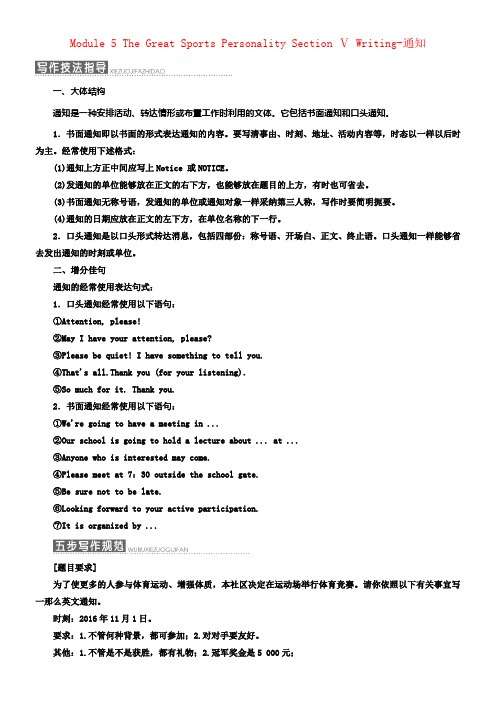
Module 5 The Great Sports Personality Section Ⅴ Writing-通知一、大体结构通知是一种安排活动、转达情形或布置工作时利用的文体。
它包括书面通知和口头通知。
1.书面通知即以书面的形式表达通知的内容。
要写清事由、时刻、地址、活动内容等,时态以一样以后时为主。
经常使用下述格式:(1)通知上方正中间应写上Notice 或NOTICE。
(2)发通知的单位能够放在正文的右下方,也能够放在题目的上方,有时也可省去。
(3)书面通知无称号语,发通知的单位或通知对象一样采纳第三人称,写作时要简明扼要。
(4)通知的日期应放在正文的左下方,在单位名称的下一行。
2.口头通知是以口头形式转达消息,包括四部份:称号语、开场白、正文、终止语。
口头通知一样能够省去发出通知的时刻或单位。
二、增分佳句通知的经常使用表达句式:1.口头通知经常使用以下语句:①Attention, please!②May I have your attention, please?③Please be quiet! I have something to tell you.④That's all.Thank you (for your listening).⑤So much for it. Thank you.2.书面通知经常使用以下语句:①We're going to have a meeting in ...②Our school is going to hold a lecture about ... at ...③Anyone who is interested may come.④Please meet at 7:30 outside the school gate.⑤Be sure not to be late.⑥Looking forward to your active participation.⑦It is organized by ...[题目要求]为了使更多的人参与体育运动、增强体质,本社区决定在运动场举行体育竞赛。
2017-2018学年高中英语 Module 5 The Great Sports Personality单元小结教学案 外研版必修5

Module 5 The Great Sports PersonalityLi Ning is not only a man's name but also abrand of sportswear. Who created the brand? LiNing, a worldfamous gymnast. Li Ning performedwell and won 106 gold medals in all, includingthree Olympic ones. When he retired at 26, hedecided to start a new life using his sporting background.Li Ning founded a company to make tracksuits and quickly succeeded. Its logo is LN and slogan is anythingispossible. The major advantage of his products is that they are cheaper than those wellknown competitors. The demand for his products was on the increase with sport being popular, which guaranteed his success. At Beijing Olympic Games, when the athletes wearing his sportswear stood on the platform, the excited audience rose to their feet, shouting and cheering to celebrate victory.Li Ning's product is so popular that now it is purchased every ten seconds. Li Ning employs Italian designers to create new styles. Now, owning a Li Ning's product is a symbol of health. Li Ning is also a man of high quality. His ultimate dream was to open a school for training gymnasts. His dream came true in 1991. Li Ning also encourages teenagers to take part in more sports, including marathon, a tough race, which builds up one's strong will.李宁既是一个人的名字,也是运动服的品牌。
外研社高二英语必修5module5thegreatsportspersonality教案全面版
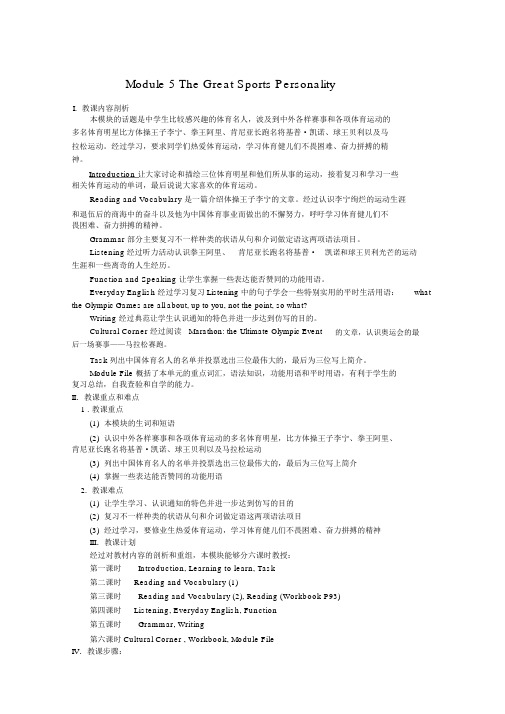
Module 5 The Great Sports PersonalityI.教课内容剖析本模块的话题是中学生比较感兴趣的体育名人,波及到中外各样赛事和各项体育运动的多名体育明星比方体操王子李宁、拳王阿里、肯尼亚长跑名将基普·凯诺、球王贝利以及马拉松运动。
经过学习,要求同学们热爱体育运动,学习体育健儿们不畏困难、奋力拼搏的精神。
Introduction 让大家讨论和描绘三位体育明星和他们所从事的运动,接着复习和学习一些相关体育运动的单词,最后说说大家喜欢的体育运动。
Reading and Vocabulary 是一篇介绍体操王子李宁的文章。
经过认识李宁绚烂的运动生涯和退伍后的商海中的奋斗以及他为中国体育事业而做出的不懈努力,呼吁学习体育健儿们不畏困难、奋力拼搏的精神。
Grammar 部分主要复习不一样种类的状语从句和介词做定语这两项语法项目。
Listening经过听力活动认识拳王阿里、肯尼亚长跑名将基普·凯诺和球王贝利光芒的运动生涯和一些离奇的人生经历。
Function and Speaking让学生掌握一些表达能否赞同的功能用语。
Everyday English经过学习复习Listening 中的句子学会一些特别实用的平时生活用语:what the Olympic Games are all about, up to you, not the point, so what?Writing 经过典范让学生认识通知的特色并进一步达到仿写的目的。
Cultural Corner 经过阅读Marathon: the Ultimate Olympic Event的文章,认识奥运会的最后一场赛事——马拉松赛跑。
Task列出中国体育名人的名单并投票选出三位最伟大的,最后为三位写上简介。
Module File 概括了本单元的重点词汇,语法知识,功能用语和平时用语,有利于学生的复习总结,自我查验和自学的能力。
高中英语Module5TheGreatSportsPersonality单元要点归纳提升课件外研

2021/4/17
高中英语Module5TheGreatSportsPersonality
6
单元要点归纳提升课件外研版必修5
4.score n.得分;二十 vi. & vt. 记分;得分
a
(1)score __________ goal
进球
score full ___m_a_r_ks____ 得满分
3.So what? 那又怎么样?
for
What __________? 为什么?
if
What __________...?
如果……将会怎么样/怎么办?
about
What __________...?
……怎么样?(征求意见)
up
What's __________? 怎么啦?/出什么事了?
2021/4/17
__________________________________________
2021/4/17
高中英语Module5TheGreatSportsPersonality
21
单元要点归纳提升课件外研版必修5
3.他在比赛中表现很好,获得了最高分,荣获了全国冠军。
(perform;score;champion)
4
单元要点归纳提升课件外研版必修5
2.advantage n. 优势;长处;有利条件(因素)
of
(1)take advantage __________
利用
over
have/gain/win an advantage __________ sb. /sth.
胜过;优于
of
have an advantage __________ (doing)sth.
高三英语复习 Module 5 The Great Sports Personality语言知识案

2017届高三英语一轮复习Module 5 The Great Sports Personality语言知识案(无答案)外研版必修5编辑整理:尊敬的读者朋友们:这里是精品文档编辑中心,本文档内容是由我和我的同事精心编辑整理后发布的,发布之前我们对文中内容进行仔细校对,但是难免会有疏漏的地方,但是任然希望(2017届高三英语一轮复习Module 5 The Great Sports Personality语言知识案(无答案)外研版必修5)的内容能够给您的工作和学习带来便利。
同时也真诚的希望收到您的建议和反馈,这将是我们进步的源泉,前进的动力。
本文可编辑可修改,如果觉得对您有帮助请收藏以便随时查阅,最后祝您生活愉快业绩进步,以下为2017届高三英语一轮复习Module 5 The Great Sports Personality语言知识案(无答案)外研版必修5的全部内容。
Module5 The Great Sports Personality语言知识探究案Ⅰ。
词形变换【自主学习】1. ____________ n. 运动员→ athletic adj.运动的2. ____________ v。
退休→____________ n.退休→____________ adj.退休的3. ____________ n。
优势;长处→ disadvantage n。
不利条件4。
____________ v。
表现→performer n.执行者;表演者→____________ n。
表现;表演5. ____________ v。
训练→trainee n。
接受培训者,实习生→____________ n. 运动鞋;教练员→____________ n。
训练,培养6。
____________ v. 购买→purchase n.购买7. increase v。
增加;增长→____________ n。
增加;增长→____________ adj. 越来越多的→ increasingly adv. 越来越多地→____________ v。
外研版高中英语必修5 Module 5《The Great Sports Personality》word教案
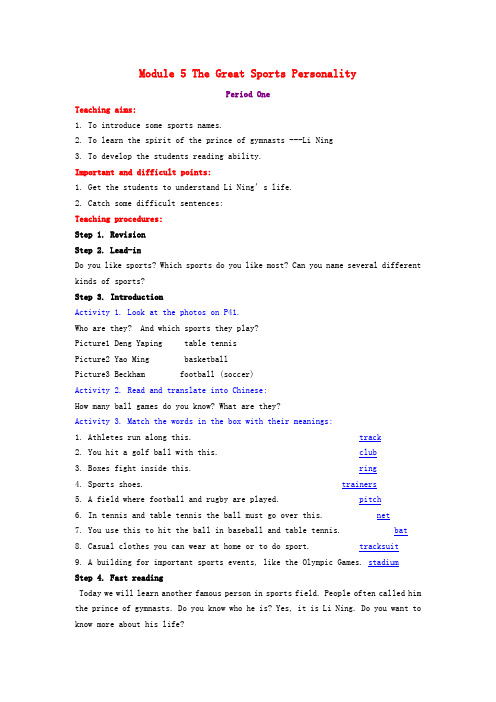
Module 5 The Great Sports PersonalityPeriod OneTeaching aims:1. To introduce some sports names.2. To learn the spirit of the prince of gymnasts ---Li Ning3. To develop the students reading ability.Important and difficult points:1. Get the students to understand Li Ning’s life.2. Catch some difficult sentences:Teaching procedures:Step 1. RevisionStep 2. Lead-inDo you like sports? Which sports do you like most? Can you name several different kinds of sports?Step 3. IntroductionActivity 1. Look at the photos on P41.Who are they? And which sports they play?Picture1 Deng Yaping table tennisPicture2 Yao Ming basketballPicture3 Beckham football (soccer)Activity 2. Read and translate into Chinese:How many ball games do you know? What are they?Activity 3. Match the words in the box with their meanings:1. Athletes run along this. track2. You hit a golf ball with this. club3. Boxes fight inside this. ring4. Sports shoes. trainers5. A field where football and rugby are played. pitch6. In tennis and table tennis the ball must go over this. net7. You use this to hit the ball in baseball and table tennis. bat8. Casual clothes you can wear at home or to do sport. tracksuit9. A building for important sports events, like the Olympic Games. stadiumStep 4. Fast readingToday we will learn another famous person in sports field. People often called him the prince of gymnasts. Do you know who he is? Yes, it is Li Ning. Do you want to know more about his life?Read the text and answer the following questions.1. How many gold medals had he won when Li Ning retired?2. Whose names were on the list together with Li Ning?3. What is the red logo made up of?4. What is their major advantage over others?5. Are Li Ning products popular in some schools?6. Was it Li Ning’s goal to make money when he retired?(Answers: 1. When he retired at the age of 26, he had won 106 gold medals in major competitions across the world. 2. Li Ning’s name was on it, together with footballer Pele and boxer Muhammad. 3.The bright red logo is made up of the first two pinyin letters of Li Ning’s name, Land N. 4. Li Ning’s designs were attractive and they had a major advantage over their better known rivals— they were cheaper. 5. Yes, they are. 6. No, it wasn’t.)Step 5. Further readingRead the passage again and check the true statements in Activity3.Answers: 1,2,4,5,8 are true.Step 6. VocabularyDo Activity 5 and 6 by themselves ,then check the answers together.Answers: Activity 5:(1)medal(2)determined(3)launch(4)brand(5)sports wear(6)global giant(7)logo(8)rivals(9)step out(10)goal/ dream/ ambitionStep 7. Discussion:1. Why did Li Ning start a spotswear company?2. Why has he been successful?Step 8. Homework1. Workbook on P92 Exx. 5,6,7.2. Write a short passage about Li Ning’s life.Period TwoTeaching aims:1. To listen to the famous persons in the sports field.2. To develop the students listening ability by listening to the programmes.3. To express agreeing and disagreeing: degrees of certainty.4. To learn several phrases: up to you; not the point: so what….Important and difficult points:1. Get the students to catch the main information about numbers.2. How to catch the key words in the listening.Teaching procedures:Step 1. RevisionStep 2. Listening:Before listening: Look at the pictures and name the sports.What is the name of the sport they are playing?While listening:Activity 1: listen to Part1 twice and check the answers together:(Answer: 3. Vote for the greatest sports personality ever.)Activity 2: listen to Part2 twice and check the answers together:Answers: 1. Because he became a Muslim.2. Poems about his fights. 3. 2 4. With his head. 5. Just before the end of the race, he had terrible pain and had to pull out of the race. 6. His bus got stuck in a traffic jam.)Listen to Part2 the third time and fill in the blanks.1. He was born with the name Cassius Clay, but he changed this to Muhammad Ali when he changed his _____ and became a Muslim.2. Outside the ring, he was known as a _______ .He wrote poems about his fights.3. Although the doctor told him to stay in bed, he was _____ for another race—the 1500 metres.4. But the bus got stuck in a ________ jam---so what did he do?5. When he began playing football as a _________ he worked cleaning shoes.6. They played Italy in the final and Pele scored a ______ goal with his head. Afterwards he said it was his_____ goal.(Answers: 1. religion 2. poet 3. entered 4. traffic 5. teenager 6. fantastic, favourite)After listening: Complete the facts below according to your listening. Muhammad AliBecame world champion in _1964___.Gold medal in Rome OlympicsWon 22 out of 24 world championship fights.Kip KeinoSilver medal in 5000 metresGold medal in 1500 metresWinning time 3`34.9PeleAge in his first world cup 17Number of world cups 4Total number of goals scored 1280Step 3. Function and Speaking.Activity1: Read the dialogue and answer the following questions:1. What are the boy and the girl talking about?2. Who does the boy think is the best, Pele, Muhammad Ali or Kip Keino?3. Who does the girl think is the best, Pele, Muhammad Ali or Kip Keino or anyone else?Look at the underlined expressions and answer the questions:1. Which expressions are used to show agreement?2. Which expressions shows the speaker is not sure that he agrees?3. Which expressions is used to show disagreement?(Answers:1. I agree absolutely; you are right about that. 2.You may be right. 3. That is not the point; I am afraid I don’t agree.)Activity 2: Work in pairsPair the students. Ask them to prepare their respective parts individually. Read through the example with the whole class. Try to encourage them to get some expression into their voices when they agree and disagree.Step 4. Everyday EnglishChoose the correct meanings1. Ask the students to complete the sentences individually, then check with a partner.2. Give the answers: 1--a ; 2--a ; 3—a ; 4--b3. Let several students make sentences with the phrases.Step 5. HomeworkFinish off the Exx. of workbook..Period ThreeTeaching aims:1. To understand the ultimate Olympic Event—Marathon.2. To develop the students reading ability.3. To learn to write a notice.Important and difficult points:1. Get the students to grasp the history of marathon2. Teach them how to write a notice.Teaching procedures:Step 1. RevisionStep 2. Brainstorms:1. Where does the name of the marathon come from?2. Do you think that the marathon is an exciting event? Why or why not?Step 3. Reading the passage and do the following questions:1. Read and answer the questions in pairs.(1)What are the origins of the marathon?(2)When was the distance of marathon changed?(3)Why did the 1908 Marathon end dramatically?(4)Why don’t you have to wait for the Olympic Marathon?(5)What is the toughest course to run in marathon?(6)Why is the marathon the Olympic event?[Answers:(1)The name of the race comes from a battle in Ancient Greece. (2) In 1908, at the London Olympics, it was changed. (3) When the leader, an Italian, entered the stadium the turned the wrong way and fell onto the ground. Officials picked him up and helped him to the finishing line, just as the second runner, an American entered the stadium, At last, the American runner was declared the winner. (4) Because there are marathons in over sixty countries and hundreds of cities around the world today. (5)The Great Wall Marathon. (6) Because it is thought to be the hardest.]2. Read and do the T or F questions:(1)The marathon is the first and the most exciting event in the Olympics (F)(2)At first, the distance of marathon is 42 kilometers. (F)(3)One of the most famous marathon is in London. (F)Step 4. DiscussionDiscuss in groups of four:Student A: the origins of the marathonStudent B: the distance of the marathonStudent C: the 1908 MarathonStudent D: the New York Marathon and the Great Wall MarathonInvite several groups to show their discussion.Step 5. WritingActivity 1: Read the notice below and answer the questions:1. Ask the students to complete the activity individually, then check with a partner.2. Call back the answers from the whole class: (1) –a (2)---b (3) ---c Activity 2: Write a similar notice. Use these steps to help you.(1)Choose a different sport.(2)You are the trainer for your school team. Write a notice for the team givinginformation about the next event.(3)Use the notice on the text to give you ideas.Let one student come to the front and write down on the blackboard.Step 6. HomeworkWrite a short history of the Olympic Games for China Daily. Use the headings in the fact files to write one paragraph on each topic.(1)history(2)changing games(3)winners(4)three things everyone should knowPeriod FourTeaching aims:1. To review of adverbial clauses.2. To learn new words and expressions and how to use them.3. To learn a sentence : It is /was +被强调的部分 +that /who+其他。
- 1、下载文档前请自行甄别文档内容的完整性,平台不提供额外的编辑、内容补充、找答案等附加服务。
- 2、"仅部分预览"的文档,不可在线预览部分如存在完整性等问题,可反馈申请退款(可完整预览的文档不适用该条件!)。
- 3、如文档侵犯您的权益,请联系客服反馈,我们会尽快为您处理(人工客服工作时间:9:00-18:30)。
Module 5 The Great Sports Personality Section Ⅲ Grammar-复习状语从句语法图解探究发现①When he retired at the age of 26, he had won 106 gold medals in major competitions across the world.②But even though he had won everything it was possible to win in his sport, Li Ning retired with the feeling that he had failed.③Please take your raincoat along with you in case it rains.④If you go into a school or university anywhere, the chances are you will see students in Li Ning tracksuits with the familiar logo.⑤Whenever Chinese athletes step out onto the track during the 2008 Olympics, they will be wearing Li Ning tracksuits.⑥As the leader comes into the stadium to run the last few metres of the 42kilometre race, the crowd rises to its feet to shout and cheer.⑦While I don't like his design at all, I attended the meeting.⑧Although he is very old, he knows little about how to deal with this kind of people.[我的发现](1)判断上述状语从句的类型:②⑦⑧是让步状语从句;③④是条件状语从句;①⑤⑥是时间状语从句。
(2)even though引导让步状语从句时,可用even_if来替换。
一、时间状语从句1.when引导的时间状语从句when引导的时间状语从句的谓语动词可以是延续性动词,也可以是终止性动词;从句的动作和主句的动作可以同时发生,也可以先后发生。
It was snowing when we got to the airport.我们到达机场时,天正下着雪。
(同时发生)He went home when he had finished his homework.做完作业后他回家了。
(先后发生)[名师点津] whenever意为“每当,每每”时,也能引导时间状语从句。
Larry always blames me whenever anything goes wrong.每每什么事情出现问题,拉里总是责怪我。
2.while引导的时间状语从句while引导的时间状语从句的谓语动词是延续性动词或表示状态的动词,并强调主句和从句的动作同时发生。
Please write while I read.我念的时候,请写下来。
He listens to the radio while driving to work.他去上班时一边开着车一边听广播。
3.as引导的时间状语从句as表示“一边……一边……,随着”,as引导的时间状语从句动作是延续性的动作,一般主句和从句动作同时发生。
I hurt my shoulder as I was playing basketball.我打篮球时弄伤了肩膀。
(本句中的as 可用when 或者while替换)4.since引导的时间状语从句since引导时间状语从句时,表示“自从……”,从句中的谓语动词常用瞬间动词。
一般情况下,从句的谓语动词用一般过去时,而主句的谓语动词用现在完成时。
He has written to me frequently since I got sick.自从我病了以后,他经常给我写信。
5.till和until引导的时间状语从句这两个词的用法类似,都表示“直到……才”,但till不用于句首;用于肯定句时,主句要用延续性动词,用于否定句时,主句要用非延续性动词。
I waited till/until 9:00.我一直等到9点钟。
(wait为延续性动作)I didn't go to bed until/till my father came back.我直到父亲回来才上床睡觉。
(go to bed为非延续性动作)6.before引导的时间状语从句before引导时间状语从句时,意为“在……之前;……之后才;没来得及……就……”,常表示主句动作先于从句动作发生。
从句一般不能为否定句。
He had put the broken vase away before his mother came back.他趁妈妈还没回来把打碎的花瓶收拾好了。
7.after引导的时间状语从句after表示主句动作发生在从句动作之后。
主句用一般过去时,从句可以用一般过去时,也可以用过去完成时。
He called me after he had finished his work.工作完了之后他给我打了个电话。
8.名词词组作连词引导的时间状语从句表示时间的名词词组也可以引导时间状语从句。
常见的这类名词词组有:the time, the moment, the minute, the day, the year, the first time, the second time, each time, every time, next time, any time等。
The moment he reached the country, he started his search.他一到达这个国家,就开始他的搜寻工作。
9.表示“一……就……”的连词或结构引导的时间状语从句as soon as, immediately, directly, instantly, no sooner ...than ..., hardly/scarcely ... when ...都意为“一……就……”,表示从句动作一发生,主句动作随即发生。
Directly you feel any pains, you must go to the doctor.你一感觉疼痛就必须去找医生。
No sooner had she gone to sleep than the telephone rang once more.她刚睡着,电话就又响了。
[名师点津] 注意no sooner ...than ..., hardly/scarcely ...when ...结构的时态搭配, no sooner与hardly/scarcely引导的主句谓语动词应用过去完成时,而than与when的从句中的谓语动词应用一般过去时。
此外,当把no sooner和hardly/scarcely提到句首时,句子应用部分倒装语序。
10.时间状语从句的几个常用句型(1)It is/has been+时间段+since ...(从句用一般过去时)“自……以来已有多长时间了”,从句谓语用短暂性动词时,表示动作持续了多久,用延续性动词时,表示动作停止了多久。
How long is it since we met last time?自上次我们见面以来有多长时间了?(2)It is/was+时间点+when ...“当……的时候已是……”。
It was midnight when they finished the work.他们完成工作的时候已是午夜了。
(3)句型“It be+时间段+before ...”中it指时间,主句常用一般将来时或过去时。
主句中的表语多为long, not long, three days, two weeks等表示时间段的词或短语。
It was not long before I left for London.不久我就动身去伦敦了。
[即时演练1](1)句型转换(每空一词)①His mother went to bed after he came bac k.→His mother didn'tgotobeduntil/till he came back.②The moment I saw him, I gave him all the books.→I gave him all the books assoonas I saw him.③I didn't recognize her before she took off her cap.→I recognized her aftershetookoffhercap.④He came to ou r school three months ago.→Itisthreemonthssince he came to our school.(2)单句改错①I was about to say while you interrupted me.while→when②It will not be long before you will get used to the life here.去掉第二个will③Immediate he came back, his mother told him th e news.Immediate→Immediately二、条件状语从句1.if和unless引导的条件状语从句if表示正面的条件,意为“如果”;unless(=if not)表示负面的条件,意为“除非,如果不”。
If you fail in the exam, you will let him down.如果你考试不及格,你会让他失望的。
You will fail to arrive there in time unless you start earlier.=You will fail to arrive there in time if you do not start earlier.如果你不早点动身,你就不能及时赶到那儿。
[名师点津] if从句还表示不可能实现的条件或根本不可能存在的条件,也就是一种虚拟的条件或假设,从句多用一般过去时或过去完成时。
